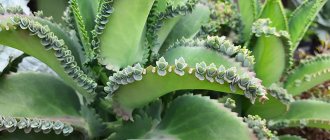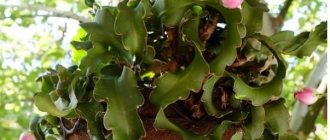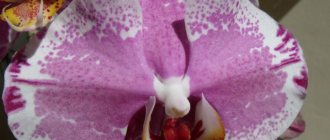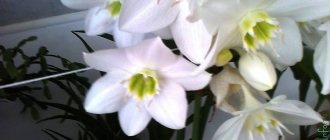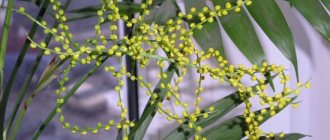Psychopsis is an epiphytic plant belonging to the orchid family. In the past, this variety of orchids was classified as an oncidium species, but at the moment they are positioned as an independent group. Attention to psychopsis is attracted by their delicate flowers, which resemble soaring colorful butterflies over the green stems of the plant. They are often found in Latin America and nearby islands, growing in tropical forests.
In Russia, you can purchase this unusual orchid in large flower hypermarkets or online stores.
You can also buy a seedling from flower growers, but so far psychopsis is rare. [Hide]
Types and varieties
Psychopsis mariposa is native to Central and South America. The orchid grows in tropical forests on tree trunks. The plant has dark green leaves. If the lighting is good, specks and marble stripes may appear on them. Peduncles are tall, thin, strong and straight.
Orchids have a revolving type of flowering, that is, first one bud appears and as it fades, the peduncle throws out another one. The flowers are orange-yellow in color and shaped like moths. Their sizes reach up to 15 centimeters.
Psychopsis papilio - grows in the tropical forests of Ecuador, Venezuela and Peru. Psychopsis moth is an epiphyte reaching a height of 19 to 28 centimeters. Plant pseudobulbs can be oval or round, wrinkled, flattened, and often have speckles or dirty red spots on them. Each bulb produces one leaf, reaching a length of up to 23 centimeters.
The leaves are straight, matte green with veins or reddish spots. The peduncle of the plant reaches from 61 to 152 centimeters in height. Over the course of several months, one flower appears on it, which bloom according to the pattern: one by one. The flowers resemble moths and are flecked with reddish-yellow. The length of the flowers is up to 15 centimeters.
Psychopsis papilio peloric is a plant belonging to the Oncidium family. Orchid flower stalks constantly form buds, so the orchid can bloom for several years. As a result of prolonged flowering, the length of the peduncle can reach a length of 1 meter.
The plant has straight green leaves and reddish-orange flowers interspersed with yellow, reminiscent of exotic butterflies.
Psychopsis kalihi
It is a hybrid of two orchids: psychopsis papilio and kramer. The plant has erect leaves, the length of which is 25 centimeters. Peduncles are rigid, straight, reaching a length of up to 1 meter.
The size of pseudobulbs is up to 4 centimeters. They throw out one sheet at a time. Orchid flowers are yellow-brown in color with burgundy splashes. The flower size reaches from 12 to 15 centimeters.
Psychopsis Kalihi mountain alba - the plant belongs to the Oncidium family. Peduncles reach 1 meter in length. The leaves are green with dark spots. One leaf grows from one pseudobulb. The orchid has a revolving type of flowering (buds appear one after another). The flowers are bright yellow with light yellow marbled stripes.
Psychopsis butterfly - has pseudobulbs that produce two dark green leaves with marbled inclusions. The length of the peduncle reaches 120 centimeters. One bud blooms on it. The flowers are orange in color with brown spots. They are large in size and brightly colored.
Psychopsis mendenhall - the plant has wide, thick, dark green leaves with small marbled splashes of purple. The peduncle can reach one meter and has a revolving type of flowering. The orchid flowers themselves are quite large and have an orange-yellow color.
Psychopsis krameriana
It has flat, oval bulbs that produce a pair of dark green leaves with reddish splashes. Their length ranges from 15 to 20 centimeters. The peduncle reaches a length of 1 meter. A bud blooms on it, turning into a large yellow flower with red-brown splashes.
Psychopsis limminghei - has a compact size. The leaves have a dark green tint with small dark spots. Their length is up to 5 centimeters. The peduncle is up to 10 centimeters long. One bud appears on it, turning into an unusual flower with a yellow-brown color.
Psychopsis versteegiana is native to the tropical forests of Ecuador, Peru and Bolivia. The plant has a long, hard peduncle on which exotic orchid buds appear. The dark green leaves of psychopsis reach a length of 5 to 10 centimeters. The flowers are red and yellow in color with unusual three red petals, similar to the feathers of a tropical bird.
Psychopsis sanderae - has a long, hard peduncle on which two to three buds bloom. The flowers are bright yellow with orange splashes. Psychopsis leaves are dark green with purple splashes.
General information
Psychopsis is Greek for resembling or similar to a butterfly .
Flowers resemble a butterfly, a moth. A large three-lobed lip with corrugated edges is the abdomen, oblong fused lateral sepals are the wings, a vertical column is the head, narrow petals and the upper sepals are the antennae.
With a slight blow of wind, the flower begins to sway, creating the effect of a flying butterfly.
The second option for the origin of the name is the name translated from Latin “Psyche” - the name of the goddess, translated as soul. There is a legend in which they say that the girl Psyche was very beautiful. And when they made her a goddess, they awarded her with wings similar to the wings of a butterfly.
In nature , Psychopsis is found in Central and South America, where it grows on trees at an altitude of 300 to 1000 meters above sea level.
Fine plant roots cling to the bark of trees in tropical forests. pseudobulbs are small – 3.5–5 cm in height, flattened, green. False bulbs produce one leaf at a time.
The leaf blades are long, lanceolate, rigid, slightly bent along the median vein. Dark green leaves have a reddish tint. In addition, the reverse surface is often decorated with a scattering of purple spots.
peduncle extends from the base of the pseudobulb . The length of the vertical flower arrow reaches up to a meter. As a rule, it bears a single bud. Sometimes a flower shoot branches, then the number of flowers increases.
Red-brown, cream, yellow flowers, decorated with spots, appear one after another. Each of them lasts 3-4 weeks. Revolving flowering lasts for many months.
Psychopsis care at home
Caring for a plant may seem complicated, but in fact it is very simple to grow; the main thing is to follow the rules and the plant will delight you with its delicate flowers and beauty for a long time. Dark green leaves, against which bright exotic flowers stand out, will not leave any gardener indifferent.
Plants are not picky about air humidity. However, you can install a humidifier or simply ventilate the room with the orchid more often. The most comfortable temperature for psychosis is +25 degrees during the day and + 20° at night.
Also, the length of daylight hours is very important for orchids. It must be at least 11 hours. The plant should avoid direct sunlight, and backlighting should be used in autumn and winter.
Cymbidium is also a member of the orchid family. It can be grown with care at home without much hassle if the necessary maintenance rules are followed. You can find all the necessary recommendations in this article.
Secrets of success
Psychopsis feels most comfortable at year-round air temperatures of +25°C during the day and +20°C at night. However, the plant is able to adapt to summer heat (up to +32°C) and winter cold (not lower than +15°C).
These orchids need long (10-11 hours) daylight hours. But they need to be protected from direct sunlight. In apartment conditions, it is recommended to use lighting from autumn to spring.
Since Psychopsis does not have a rest period, watering is carried out throughout the year. An indispensable condition: the soil must have time to dry. In winter, procedures are performed less frequently, reducing the volume of fluid. Partial immersion watering gives good results. With the usual method, you need to make sure that water does not get on new growths and flower stalks.
There are no breaks in feeding orchids. Special fertilizers of reduced concentration are applied in spring and summer with every second watering, and less frequently in autumn and winter.
Psychopsis does not have any special requirements for air humidity. If there is a need to install humidifiers, it is necessary to increase the frequency and duration of ventilation.
Plants live happily outdoors from May to September. True, only in places protected from bright sun, winds and rain.
Watering psychosis
To prevent the soil from becoming waterlogged and dry out, since this type of orchid does not have a dormant period, psychopsis should be watered all the time. However, to prevent the root of the flower from rotting, you should check the dryness of the soil before the next watering; it must have time to dry out.
Psychopsis should be watered less often in winter, reducing the volume of water. You can moisten the soil using the partial immersion method. When watering an orchid in the usual way, you need to make sure that the liquid does not get on the peduncle or new shoots.
Home care
Tropical conditions are created for a tropical beauty on the windowsill. The room temperature is maintained from 20 to 27 degrees. Air humidity is created within 60-80% using spraying and additional containers with water.
Attention! Spray should be done carefully, without getting water into the axils of the leaves.
Lighting is required to be bright, without direct sunlight.
Watering is not a method of hydration. There should be little water in the pot. The next watering is done only after the substrate has dried.
Stress stimulates the orchid to bloom: a sharp decrease in the number of spills and a decrease in air temperature by 5-6 degrees.
For each variety there are separate nuances in content. Before purchasing orchids, you need to study them.
It is best to feed orchids with special fertilizers according to the instructions: little by little, but weekly.
Disease prevention involves strict adherence to watering, humidity, temperature and lighting regimes.
Fertilizer for psychosis
There are no breaks in feeding the plants. Many novice gardeners ask: how to feed psychopsis so that it blooms and does not lack nutrients?
For this purpose, specialized fertilizers for psychopsis are used, which have a reduced concentration of nitrogen and urea.
After winter, Psychopsis should be fed with every third watering; in autumn-winter, this should be done less often.
Ground for psychosis
The soil for psychopsis must be moist and breathable. For this reason, you should buy it specifically for orchids; another will not work.
The composition of the soil should include pine bark, moss, expanded clay, charcoal and nut shells. This composition is an ideal option for planting a plant, as it allows you to simulate the growing conditions of psychopsis in the wild.
Psychopsis transplant
In order for the plant to feel comfortable, it should be planted in a pot made of plastic or clay, which must have drainage holes.
Psychopsis transplantation is carried out two to three times a year. The optimal time can be determined by the condition of the plant roots. It is better to wait until the new shoot develops its own root system.
Psychopsis, unlike other orchids, tolerates transplantation easily and recovers quickly. But in order for the plant to feel normal in the new soil, it needs to be properly watered and fertilized from time to time.
Bat plant
Many exotic flowers have unusual shapes and colors. The Bat flower itself is an inflorescence. The bat is sometimes called the "Devil Flower", "White Dove" or "Bat Flower".
The unique plant has nothing in common with orchids and belongs to the Tacca family , which grow in life in the south and east of Asia, India, Malaysia and the south of America with varied climatic conditions:
- open or shaded bushes;
- seashore and savannah;
- rainforests and high mountains.
Tacca is a perennial plant with creeping or tuberous roots that can grow on any soil: sand, stones, gravel, loam, clay, limestone and even volcanic rocks. The height of the plant is from 40 to 100 cm, some species stretch up to 3 meters.
Few large basal leaves and inflorescences are formed on the flower. These include only three species; the flowers differ in the upper pair of bracts.
The flowers of Takka Bat in an umbellate inflorescence are bisexual and are located on small pedicels with long thread-like “whiskers”. The spathe consists of four bracts in two circles. The fruit is a berry with seeds up to 5 mm long.
At home, the takka bat is extremely rare. She prefers western and eastern windows, without direct sunlight. Northern window sills will require additional lighting. In the spring and autumn of the Bat, the temperature is maintained within 25 degrees.
Takka "Bat".
Important! Drafts are detrimental to the Bat Taka.
From this video you will learn how to care for Takka the Bat:
Pruning psychosis
All orchids need pruning from time to time, and psychopsis is no exception. Pruning the plant, or rather its peduncle, is carried out only when it dries out on its own.
While the stem of the peduncle is elastic and green, you cannot touch it, as new buds will appear on it. After it dies, the peduncle can be removed without fear of harming the plant.
Orchids of the genus Psychopsis - taming the “insect”
The flowers of Psychopsis orchids look like bizarre insects. Despite such a fantastic appearance, caring for them is the same as for orchids of the oncidium group. But there are certain subtleties.
Psychopsis loves bright sunlight and tolerates direct morning and evening sun. However, on southern windows in the summer it is better to shade it to avoid burns.
There is information that psychopsis grows and blooms well under fluorescent lamps. I cannot confirm this opinion, since I keep my copy on the windowsill of the southwest window all year round.
FOR ACTIVE growth and regular flowering, lighting must be not only bright, but also long-lasting.
TEMPERATURE AND WATERING
There is practically no dormant period for psychopsis; they grow and bloom all year round, adapting to room temperatures. In my conditions in the warm season it is usually +22-25 degrees. during the day and +18-22 degrees. at night. The orchid tolerates summer heat with abundant watering. In winter, during severe frosts, the temperature on the windowsill drops to +15 degrees, the soil dries out more slowly, then I reduce watering.
I water the psychopsis carefully, along the edge of the pot, so that the water does not get on the young growths and developing flower stalks, which easily rot.
I feed it in spring, summer and early autumn twice a month with a special fertilizer for orchids or a weak solution of a regular complex fertilizer. If growth does not stop in winter, I continue to feed, but once every 3-4 weeks.
In an apartment with a humidity of 40-60%, psychopsis feels comfortable, so I don’t spray the plant.
PLANTING AND REPRODUCTION
Psychopsis plants are replanted as the substrate becomes salinized and decomposed. They tolerate transplantation well - neither growth, nor development of buds, nor flowering stops.
A mixture of sphagnum and fern roots with the addition of charcoal or medium-fraction pine bark (0.5-1.5 cm) with the addition of sphagnum and charcoal is usually recommended as a substrate. My psychopsis grows in the pure cortex of the middle fraction.
A small pot is selected, the orchid is planted so that the old pseudobulbs are close to the edge of the pot and there is room for future growth.
At home, psychopsis is propagated by dividing an adult healthy bush. Each division should have at least three pseudobulbs - then they will take root faster and better.
ABOUT FLOWERING
The peduncle grows from the base of the pseudobulb, just like the young growth, but, unlike the latter, it has a round cross-section (the growth has an oval cross-section). One large flower, 15-17 cm in size, blooms on a long, up to a meter, hard, erect peduncle; it lasts for 3-4 weeks. After it withers, the peduncle continues to grow and forms another bud. Thus, under favorable conditions, the plant blooms for many years on one peduncle. A broken or damaged peduncle is able to grow a new tip from the bud closest to the broken “knee” and continue to bloom.
Natalya TSYGANSKAYA, Lisichansk, Lugansk region.
Blooming psychosis
All plants of the orchid family bloom simply divinely. Psychopsis is not inferior to them in its exoticism and beauty, the flowering of which occurs from December to February.
However, when psychopsis blooms in the revolver type, its buds can appear all year round. The flowering time of one flower is three to four weeks. Flowers have different shapes and colors, depending on the type and variety of psychopsis.
Psychopsis
Previously, the psychopsis orchid (Greek psyhee - soul, “butterfly” and opsis - “similar”) belonged to the genus Oncidium. Currently, it is a separate genus with its own species and subspecies. The homeland of psychopsis is America, its center and south with a temperate warm climate.
The structure of a psychopsis flower is a copy of a butterfly or moth. The Greek goddess Psyche is often depicted in myth as a fairy with butterfly wings.
The orchid forms unifoliate pseudobulbs with a long peduncle. Large flowers open in a “revolving” type, that is, as the previous one fades.
At home, psychopsis develops and blooms well. A temperature regime is created for them in which the difference between day and night temperatures does not exceed 5-6 degrees. On the windowsill, this genus of orchids can bloom all year round. In nature - from March to October.
Psychopsis orchids have several varieties , below you will learn about the most popular of them.
Papilionaceous
grows up to 28 cm in height It forms oval-round pseudobulbs up to 5 cm, grow closely, often with dirty red spots and specks.
Psychopsis moth.
Each bulb produces one erect leaf up to 23 cm in length. The color of the leaves is matte with veins and red spots.
The flower reaches 15 cm in length.
Kramer's Psychopsis
The epiphyte grows up to 29 cm. Pseudobulbs are formed up to 4 cm, located tightly to each other.
Dark green leaves, sometimes with a marbled pattern, of Kramer's psychopsis (Psychopsis krameriana), up to 25 cm in length, grow on the tops of the pseudobulbs, the leaves are leathery with sharp tips.
The diameter of large flowers is up to 12.5 cm.
Kramer's Psychopsis.
Limminghei (Orchid Psychopsiella limminghei)
Miniature epiphyte , which grows heart-shaped pseudobulbs no more than 2 cm in length. Leaves appear at intervals of 1-2 cm. Thin, light brown-green leaves each up to 4 cm in length with burgundy spots.
The orchid produces up to five 10-centimeter peduncles with a single flower. Flowering according to the “revolving” type. Butterfly flower up to 4 cm in diameter.
Limmynhey.
Sander (Oncidium Sanderae)
A sympodial epiphyte, forming groups of plants, grows no more than 25 cm . Pseudobulbs are matte green, ovoid, up to 4.5 cm in length.
The leaves are leathery, oval, up to 20 cm long at each tip of the bulb. Peduncles are erect, up to 35 cm long. Each arrow produces about 4 flowers up to 15 cm in length , which bloom alternately.
Blooms several months a year.
Psychopsis Sander.
Alba (Psychopsis Kalihii alba)
An epiphyte with a long peduncle up to 120 cm. On each peduncle, 1-2 butterfly flowers of delicate yellow colors with orange spots along the edges are formed.
The diameter of the flower reaches 8 cm, each of them blooms for about two weeks.
Alba.
Video description of the Psychopsis orchid:
Psychopsis reproduction
Psychopsis is propagated by bush division. Each new sprout should have three pseudobulbs. When planting divided bushes in pots, old bulbs should be placed closer to the walls so that young shoots have more room to grow.
After dividing and replanting have been done, watering must be suspended for some time.
Diseases and pests
Spider mites are small red parasites that drink plant sap. Leaves affected by mites curl and dry out. You can cope with the pest using a soap solution, which should be sprayed on the plant, or using insecticides such as Aktara.
Scale insects are small pests with a hard brown shell, which is extremely difficult to deal with. They feed on the sap of the plant, gradually destroying it. Their presence is indicated by sticky liquid on the leaves, the appearance of brown spots and drying. You can cope with them with the help of the drug Karbafos.
Mealybugs are small white parasites. They feed on the sap of the plant, which leads to its gradual drying out. Mealybug infestation is indicated by curling flowers and marbled coloring on the leaves. You can overcome the pest using the drugs Karbafos and Aktara
Fungal diseases - excessive watering promotes the appearance of mold and mildew, which leads to rotting of the root system and destruction of the plant. Transplanting the plant into new soil with preliminary treatment of the roots and the use of special antifungal drugs will help cope with this scourge.
The healing properties of psychopsis
Orchids of this type have tonic and rejuvenating properties, so psychopsis petals can be used for cosmetic purposes.
From orchid petals you can prepare a healthy bath for the skin of your hands. For this purpose, you need to take fresh orchid petals, pour boiling water over them and leave for twelve hours.
Soak your hands in the resulting infusion for fifteen minutes, then wash your hands and apply moisturizer to them. This procedure softens the skin and strengthens the nail plate.
